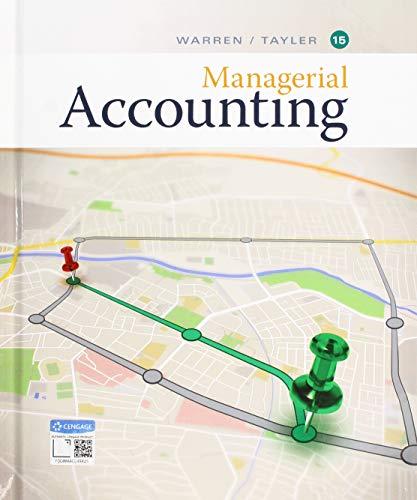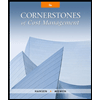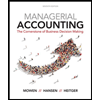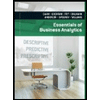
The fundamental concept behind strategic performance measurement systems is that an organization’s strategy can be represented by a set of performance measures. This basic concept of representing a complex idea (like strategy) with something more tangible (like a measure) goes back hundreds, even thousands of years. Plato’s Allegory of the Cave provides perhaps the first evidence of this concept. In the allegory, Plato describes a hypothetical scenario in which a group of prisoners is chained to a wall inside a cave, locked in a position facing away from the cave opening. Plato explains that the prisoners have been in this condition their entire lives so their knowledge of the outside world is limited to what they are able to perceive in their current state staring only at the cave wall. Plato then describes how sunlight from the outside casts shadows of anything that passes by the cave opening into the cave. These shadows appear on the wall that the prisoners are facing, and sounds from the outside echo off the shadowed wall. Plato explains that, to the prisoners, reality is not outside the cave but the shadows are reality. To them, sounds don’t come from the outside but rather from the shadows on the wall before them. Plato then goes on to discuss the status of a prisoner freed from this bondage and his initial reaction to exposure to a different reality. Plato says, “Will he not fancy that the shadows which he formerly saw are truer than the objects which are now shown to him?”
This allegory illustrates that reality can really only be indirectly perceived via imperfect representations of reality. That is what accounting is all about. Accounting measures are imperfect representations of economic ideas that cannot be seen directly—just like Plato’s shadows in the cave. Accounting measures are merely reflections of more interesting and important concepts.
 Consider financial statements and answer the following: Why do people care about what is on a firm’s balance sheet or income statement? Are they really interested in the financial statements in and of themselves, or do they use the financial statements to learn something about the issues they really care about? What are some of those issues?
Consider financial statements and answer the following: Why do people care about what is on a firm’s balance sheet or income statement? Are they really interested in the financial statements in and of themselves, or do they use the financial statements to learn something about the issues they really care about? What are some of those issues?
Trending nowThis is a popular solution!

Chapter 14 Solutions
Managerial Accounting
- The following strategic objectives have been derived from a strategy that seeks to improve asset utilization by more careful development and use of its human assets and internal processes: a. Increase revenue from new products. b. Increase implementation of employee suggestions. c. Decrease operating expenses. d. Decrease cycle time for the development of new products. e. Decrease rework. f. Increase employee morale. g. Increase customer satisfaction. h. Increase access of key employees to customer and product information. i. Increase customer acquisition. j. Increase return on investment (ROI). k. Increase employee productivity. l. Decrease the collection period for accounts receivable. m. Increase employee skills. The heart of the strategy is developing the companys human resources. Management is convinced that empowering employees will lead to an increase in economic returns. Studies have shown that there is a positive relationship between employee morale and customer satisfaction. Furthermore, the more satisfied customers pay their bills more quickly. It was hypothesized that as employees became more involved and more productive, their morale would improve. Thus, the strategy incorporated key objectives that would lead to an increase in productivity and involvement. Required: 1. Classify the objectives by perspective, and suggest a measure for each objective. 2. Prepare a strategy map that illustrates the likely causal relationships among the strategic objectives.arrow_forwardSystems Analysis Consider the following dialogue between a systems professional, Joe Pugh, and a manager of a department targeted for a new information system, Lars Meyer: Pugh: The way to go about the analysis is to first examine the old system, such as reviewing key documents and observing the workers perform their tasks. Then we can determine which aspects are working well and which should be preserved. Meyer: We have been through these types of projects before and what always ends up happening is that we do not get the new system we are promised; we get a modified version of the old system. Pugh: Well, I can assure you that will not happen this time. We just want a thorough understanding of what is working well and what is not. Meyer: I would feel much more comfortable if we first started with a list of our requirements. We should spend some time up-front determining exactly what we want the system to do for my department. Then you systems people can come in and determine what…arrow_forwardIn general, how can the understanding of the POB constructs help overcome the list of problems presented in the case? How can the manager of a unit consisting of mostly older, computer anxious, if not illiterate, employees who were very effective under the old system use positive resources to make a more successful transition to a new, technologically sophisticated operating system?arrow_forward
- Listed here are four scenarios. For each scenario, discuss the potential consequences and give a prevention technique. a) A company has recently installed a new computer network. The operating philosophy adopted by the new network administrator was to establish an open system that would foster work group date to the network users. To accomplish this objective, the data administrator assigned employee access privileges to data based on department and functional affiliation rather than specific tasks. b) Sara is a system programmer who was told she would be terminated in three weeks due to poor performance and was asked to conclude all of her projects during the three-week period. Two weeks later Sara created a logic bomb designed to get activated three months after her departure. Subsequently, the bomb destroyed hundreds of records in her previous employer’s accounts receivable invoice file. c) Matt discovered a new sensitivity analysis public-domain program on the Internet. He…arrow_forwardWhich of the following is false regarding strategic planning? It is the sole responsibility of supervisors. It will span many years. It should include both short-term and long-term goals. Strategic objectives will be diverse and vary from company to company.arrow_forwardTwo departments within Cougar Gear Inc. are Production and Sales. Each department has a unique scorecard, as follows: The Production Department scorecard focuses on the learning and growth and internal processes perspectives. The Sales Department scorecard focuses on the learning and growth and customer perspectives. Both scorecards have the learning and growth performance metrics of median training hours per employee and average employee tenure. The Production scorecard has the unique metrics of production time per unit and number of production shutdowns. The Sales scorecard has the unique metrics of percentage of customers who shop again and online customer satisfaction rating. The performance targets for each metric are shown in the tan boxes just under the performance metrics. The actual achieved metrics are shown in the red boxes just below the tan boxes. When evaluating both departments, Cougar Gears management looks at the median training hours per employee and average employee tenure metrics and subsequently decides to give the Sales Department a large bonus while giving the Production Department a minimal bonus. a. Determine and define the type of cognitive bias Cougar Gears management has exhibited in this instance. b. Determine which department would have received the larger bonus had the companys management not been biased in the evaluation. c. Discuss one advantage and one disadvantage of using unique balanced scorecards for different departments or divisions of a company.arrow_forward
- Describe ways that system theory can help you implement an OD intervention. Assume an organization wants to give more power or decision-making authority to lower level employees. Describe one intervention that might be useful for achieving the objective. Assume an organization conducted a workshop on customer service. The goal was to improve the customers experience. Describe one way you might be able to evaluate the interventionarrow_forwardExplaining why companies use performance evaluation systems Well-designed performance evaluation systems accomplish many goals. Consider the following actions and state which goal is being achieved by the action: Comparing targets to actual results Providing subunit managers with performance targets Comparing actual results with industry standards Providing bonuses to subunit managers who achieve performance targets Aligning subunit performance targets with company strategy Comparing actual results of competitors Taking corrective actions Using the adage “you get what you measure” when designing the performance evaluation systemarrow_forwardCompany B uses a responsibility reporting system to measure the performance of its three investment centers: Planes, Taxis, and Limos. Segment performance is measured using a system of responsibility reports and return on investment calculations. The allocation of resources within the company and the segment managers’ bonuses are based in part on the results shown in these reports.Recently, the company was the victim of a computer virus that deleted portions of the company’s accounting records. This was discovered when the current period’s responsibility reports were being prepared. The printout of the actual operating results appeared as follows. Planes Taxis Limos Service revenue $ ? $450,000 $ ? Variable costs 5,000,000 ? 320,000 Contribution margin ? 180,000 380,000 Controllable fixed costs 1,500,000 ? ? Controllable margin ? 70,000 176,000 Average operating assets 25,000,000 ? 1,600,000 Return on investment 12% 10% ? InstructionsDetermine the missing pieces…arrow_forward
- Explaining why companies use performance evaluation systems Well-designed performance evaluation systems accomplish many goals. Consider the following actions, and state which goal is being achieved by the action: a. Comparing targets to actual results b. Providing subunit managers with performance targets c. Comparing actual results with industry standards d. Providing bonuses to subunit managers who achieve performance targets e. Aligning subunit performance targets with company strategy f. Comparing actual results of competitors g. Taking corrective actions h. Using the adage “you get what you measure” when designing the performance evaluation systemarrow_forwardThe Chief Information Officer (CIO) and the Managing Director (MD) of Illustrious Limited recently had the following conversation regarding thedevelopment of a new information system for the company: CIO: The way to go about the analysis is to first examine the old system, such as reviewing key documents and observing the workers performing their tasks. Then we can determine which aspects are working well and which should be preserved. MD: We have been through these types of projects before, and what always ends up happening is that we do not get the new system we are promised. Instead we get a modified version of the old system. CIO: I can assure you that will not happen this time. My team just want a thorough understanding of what is working well and what is not. MD: I would feel much more comfortable if we first started with a list of our requirements. We should spend more time in determining what exactly we want the system to do upfront. Then your team can come in and determine…arrow_forwardThe Chief Information Officer (CIO) and the Managing Director (MD) of Illustrious Limited recently had the following conversation regarding thedevelopment of a new information system for the company: CIO: The way to go about the analysis is to first examine the old system, such as reviewing key documents and observing the workers performing their tasks. Then we can determine which aspects are working well and which should be preserved. MD: We have been through these types of projects before, and what always ends up happening is that we do not get the new system we are promised. Instead we get a modified version of the old system. CIO: I can assure you that will not happen this time. My team just want a thorough understanding of what is working well and what is not. MD: I would feel much more comfortable if we first started with a list of our requirements. We should spend more time in determining what exactly we want the system to do upfront. Then your team can come in and determine…arrow_forward
 Managerial AccountingAccountingISBN:9781337912020Author:Carl Warren, Ph.d. Cma William B. TaylerPublisher:South-Western College Pub
Managerial AccountingAccountingISBN:9781337912020Author:Carl Warren, Ph.d. Cma William B. TaylerPublisher:South-Western College Pub Financial And Managerial AccountingAccountingISBN:9781337902663Author:WARREN, Carl S.Publisher:Cengage Learning,
Financial And Managerial AccountingAccountingISBN:9781337902663Author:WARREN, Carl S.Publisher:Cengage Learning, Cornerstones of Cost Management (Cornerstones Ser...AccountingISBN:9781305970663Author:Don R. Hansen, Maryanne M. MowenPublisher:Cengage Learning
Cornerstones of Cost Management (Cornerstones Ser...AccountingISBN:9781305970663Author:Don R. Hansen, Maryanne M. MowenPublisher:Cengage Learning Managerial Accounting: The Cornerstone of Busines...AccountingISBN:9781337115773Author:Maryanne M. Mowen, Don R. Hansen, Dan L. HeitgerPublisher:Cengage Learning
Managerial Accounting: The Cornerstone of Busines...AccountingISBN:9781337115773Author:Maryanne M. Mowen, Don R. Hansen, Dan L. HeitgerPublisher:Cengage Learning Essentials Of Business AnalyticsStatisticsISBN:9781285187273Author:Camm, Jeff.Publisher:Cengage Learning,Business/Professional Ethics Directors/Executives...AccountingISBN:9781337485913Author:BROOKSPublisher:Cengage
Essentials Of Business AnalyticsStatisticsISBN:9781285187273Author:Camm, Jeff.Publisher:Cengage Learning,Business/Professional Ethics Directors/Executives...AccountingISBN:9781337485913Author:BROOKSPublisher:Cengage





